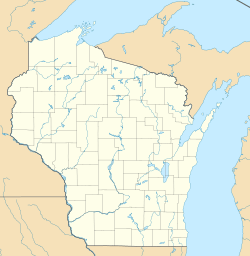Porter's Mills, Wisconsin facts for kids
Quick facts for kids
Porter's Mills, Wisconsin
|
|
|---|---|
|
Ghost town
|
|
| Country | United States |
| State | Wisconsin |
| County | Eau Claire |
| Elevation | 771 ft (235 m) |
| GNIS feature ID | 1578437 |
Porter's Mills, also called Porterville, was once a busy logging town in Eau Claire County, Wisconsin, United States. It was located near the Chippewa River. Today, it is known as a "ghost town" because it no longer exists as a populated place. It was a very important center for cutting down trees and turning them into lumber in the late 1800s.
Contents
History of Porter's Mills
Building the First Sawmill
The first sawmill in Porter's Mills was built in 1863. A man named Charles Warner built it. He chose this spot because the best places for mills in Eau Claire were already taken. This new mill was about four miles downriver from Eau Claire on the Chippewa River. It was near a natural slough, which is a swampy area. This slough was good for holding logs that were waiting to be cut.
New Owners and Growth
In 1864, Warner sold the mill to a company called Porter, Brown & Meredith. They ran the mill for two years until it burned down in 1866. After the fire, Gilbert E. Porter bought out his partners. He and his team rebuilt the mill in just 30 days! The new mill was twice as big as the old one.
Gilbert Porter had a lot of experience. He grew up on a farm, taught school, and worked in the lumber business. In 1867, Delos R. Moon bought half of the business. Later, Porter and Moon's company became the Northwestern Lumber Company. They added more partners and grew even bigger.
How the Mill Worked
The mill mainly used pine logs. These logs were cut upstream in the Chippewa valley. In the spring, they were floated down the river in large groups called log drives. The logs were kept floating in special fenced areas called booms until they were ready to be sawed.
At first, the mill used special saws called circle saws and gang saws. Later, some of these were replaced by a band saw, which is a very long, thin saw blade. The mill also had other buildings and machines. These included a shingle mill (to make roof tiles), a planing mill (to smooth wood), trimmers, edgers, and kilns (for drying wood).
In the early years, most of the lumber, shingles, and lath (thin strips of wood) were floated down the Chippewa River. They went to Northwestern's lumberyard in Hannibal, Missouri. But in 1883, the Chicago, Milwaukee & St Paul Railroad built a train line through Porter's Mills. This meant products could be shipped by train to places like Minnesota and South Dakota.
Life in Porter's Mills
By 1873, the company provided 32 houses for its married workers. Other workers owned their own homes in town. Porter's Mills was a "dry town," meaning alcohol was not sold there. This was common for many company towns.
Workers and the company generally got along well. For example, in 1881, millworkers in Eau Claire went on strike for a ten-hour workday. But the workers at Porter's Mills did not join the strike. The town faced some challenges like floods and fires, but people worked together, and the town continued to grow.
Peak Years and Decline
In 1888, the mill was very productive. It made 45,000,000 feet of lumber, 25,000,000 shingles, and 10,000,000 lath. At its busiest around 1890, almost 500 people worked there.
The town had many services for its residents. There was a public school, a post office, churches, a blacksmith, a company store, candy stores, a shoe shop, and a hotel. There was even a library association. The town's population grew to over 1,100 people. Many residents were from Scandinavian countries. In 1890, someone noted that the town hadn't had an English-speaking preacher in three months.
Eventually, the supply of pine timber upriver began to run out. The Northwestern Lumber Company started to reduce its operations in Porter's Mills in 1891. They moved their main offices to Stanley, Wisconsin, where they had another mill. The last mill in Porter's Mills was taken apart in 1899. The people who lived there moved away, many going to Stanley, Eau Claire, or other places. By 1904, Porter's Mills had completely disappeared.
Notable Residents
William Lyman Smith grew up and went to public school in Porter's Mills. He later became an important person in Wisconsin politics. He served as a member of the Wisconsin State Assembly and the Wisconsin State Senate. These are groups of elected officials who help make laws for the state of Wisconsin.


